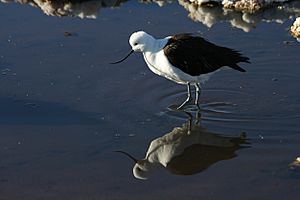Andean avocet facts for kids
Quick facts for kids Andean avocet |
|
|---|---|
 |
|
| Conservation status | |
| Scientific classification | |
 |
The Andean avocet (scientific name: Recurvirostra andina) is a large bird that loves shallow water. It belongs to the same bird family as avocets and stilts, called Recurvirostridae. This bird lives all year in the Andes mountains. It makes its nests high up, over 3,500 meters (about 11,500 feet) above sea level. You can find them in parts of northwestern Argentina, western Bolivia, northern Chile, and southern Peru.
Contents
What Does the Andean Avocet Look Like?
This avocet has a bright white head, neck, and belly. Its back, wings, and tail are a dark brown color. It's similar in size to the American avocet, but a bit more chunky. These birds are usually between 43 and 48 centimeters (17 to 19 inches) long. They weigh about 315 to 410 grams (11 to 14 ounces). On average, an Andean avocet weighs around 361 grams (12.7 ounces). This makes it likely the heaviest bird in its family!
The Andean avocet has thin, gray legs. These legs are not as long as those of other avocet types. But it has a long, thin black beak that curves upwards at the end. Male and female avocets look very much alike. Young avocets' feathers have not been fully described yet.
Its colors are similar to a local type of black-winged stilt. However, that bird has very long red legs and a straight beak. It also has a white tail.
How Do Andean Avocets Behave?
Andean avocets build their nests near shallow lakes in the Andes mountains. They often choose lakes that are a bit salty or "alkaline." These birds sometimes nest in small groups. They usually lay their eggs starting in January.
These avocets do not migrate long distances like some other birds. They stay in the same general area all year. However, they might move to slightly lower places when they are not nesting.
The Andean avocet looks for food in shallow water or on muddy ground. It often sweeps its beak from side to side in the water. This helps it find small animals like tiny crabs and insects to eat.
See also
 In Spanish: Avoceta andina para niños
In Spanish: Avoceta andina para niños
Images for kids




